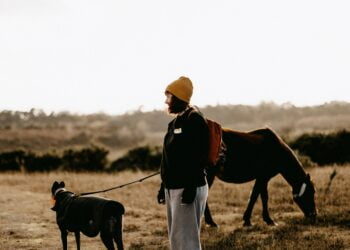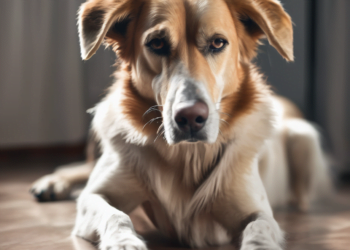Providing your beloved canine companion with the right exercise is key to their health and well-being. Regular physical activity helps keep your dog fit and strong and contributes to their mental and emotional well-being. In this article, we will delve into dogs’ optimal daily exercise requirements, providing valuable recommendations based on their activity levels.
Key Takeaways:
- Understanding your dog’s exercise requirements is crucial for overall health and happiness.
- Different dog breeds have varying exercise needs based on their breed characteristics.
- Various factors, including age, size, and overall health, influence the intensity of dog exercise.
- Puppies have unique exercise needs that support their growth and development.
- Regular exercise is equally important for adult dogs to maintain their health and prevent behavioral issues.
Understanding Your Dog’s Exercise Requirements
To determine the exercise requirements for your dog, it’s important to consider various factors such as their breed, age, size, and overall health. By understanding these factors, you can provide your canine companion with the optimal daily exercise they need.
Dogs are naturally active animals; regular exercise is essential for their physical and mental well-being. Adequate exercise helps to maintain a healthy weight, prevent obesity-related health issues, and promote good behavior by providing an outlet for their energy.
So, how do you determine the exercise requirements for your dog?
First, consider your dog’s breed. Different breeds have different exercise needs based on their inherent characteristics. For example, high-energy breeds like Border Collies or Labrador Retrievers require more exercise than low-energy breeds like Bulldogs or Basset Hounds.
Next, consider your dog’s age. Puppies have boundless energy and need frequent, short bursts of exercise to support their growth and development. Adult dogs generally require longer exercise to maintain their fitness levels. On the other hand, senior dogs may still need exercise but may benefit from low-impact activities to protect their aging joints.
Size also plays a role in determining exercise requirements. Smaller dogs may have higher energy levels and require more frequent exercise, while larger dogs may have more endurance and benefit from longer more intense workouts.
“Regular exercise is essential for dogs to maintain a healthy weight, prevent obesity-related health issues, and promote good behavior.”
In addition to breed, age, and size, it’s important to consider your dog’s overall health and fitness level. If your dog has any pre-existing health conditions or restrictions, consult with your veterinarian to determine an exercise plan that is safe and appropriate for them.
Now that you understand the factors to consider when determining your dog’s exercise requirements, it’s time to focus on providing optimal daily exercise. The exact amount of exercise your dog needs will depend on their specific needs, but as a general guideline, aim for at least 30 minutes to 2 hours of exercise per day. This can be broken into multiple daily sessions to keep your dog active and engaged.
Remember, every dog is unique, and it’s important to tailor its exercise routine to meet its individual needs. Observe your dog’s behavior and adjust its exercise regimen accordingly to ensure it is getting the right amount of physical activity.
Exercise Guidelines for Different Dog Breeds
Different dog breeds have unique exercise requirements based on their breed characteristics. It’s important to tailor the exercise routine to meet each breed’s needs to ensure their fitness and well-being. Here are some exercise guidelines for different dog breeds:
Small Breeds
Small breeds such as Chihuahuas, Yorkshire Terriers, and Shih Tzus have lower energy levels and shorter legs. Compared to larger breeds, they require less exercise. A daily walk and some interactive playtime indoors can be sufficient to keep them active and healthy.
Medium Breeds
Medium-sized breeds like Beagles, Bulldogs, and Cocker Spaniels have moderate energy levels and endurance. They benefit from daily walks, interactive games, and regular play sessions. Engaging them in activities stimulating their mind, such as puzzle toys or scent games, is also beneficial.
Large Breeds
Large breeds such as Labrador Retrievers, German Shepherds, and Golden Retrievers have high energy levels and require more exercise. Daily walks, vigorous play sessions, and opportunities for running or swimming are essential for their physical and mental well-being. Engaging them in agility training or fetch can help burn off their excess energy.
Giant Breeds
Giant breeds like Great Danes, Saint Bernards, and Mastiffs have lower energy levels but require regular exercise to prevent weight gain and keep their muscles toned. Due to their larger size, shorter but more frequent walks, and controlled play sessions are recommended to avoid stressing their joints.
| Breed Size | Exercise Guidelines |
|---|---|
| Small | Daily walks, interactive games, regular play sessions |
| Medium | Daily walks, vigorous play sessions, running or swimming |
| Large | Daily walk, vigorous play sessions, running or swimming |
| Giant | Shorter but more frequent walks, controlled play sessions |
By following these exercise guidelines based on different dog breeds, you can ensure that your furry companion gets the optimal daily exercise they need to stay healthy, happy, and well-rounded.
Factors Influencing Exercise Intensity
Understanding the factors influencing exercise intensity is crucial when designing a canine fitness regimen. By considering these factors, you can ensure that your dog’s exercise routine is effective but also safe and manageable.
Factors to Consider
- Age: Dogs of different ages have varying exercise needs. Puppies, for example, have high energy levels and require regular play sessions to aid their development. Adult dogs, on the other hand, may need more structured exercise to maintain their fitness levels. Senior dogs often have reduced mobility and may benefit from low-impact activities.
- Breed: Different dog breeds have distinct physical characteristics and energy levels. High-energy breeds like Border Collies and Labrador Retrievers require more intense exercise than low-energy breeds like Bulldogs or Pugs.
- Health Condition: Dogs with certain health conditions may have specific exercise limitations. For example, dogs with joint issues may benefit from low-impact activities, while those with respiratory problems may require exercises that don’t strain their breathing.
- Weight: A dog’s weight can impact exercise intensity. Overweight dogs may require gradual increases in exercise intensity to prevent strain on their joints, while underweight dogs may benefit from gentle activities to build strength.
- Climate: The weather and climate in your location can affect the intensity and duration of exercise. Dogs may need less intense exercise during hot and humid days to prevent heat exhaustion or dehydration.
Considering these factors, you can tailor your dog’s exercise routine to meet their needs and ensure their overall well-being. It’s important to consult with your veterinarian to develop a customized fitness plan that considers these factors.
“Understanding the factors that influence exercise intensity is key to designing a safe and effective fitness regimen for your dog.” – Dr. Olivia Thompson, Veterinarian
| Factors | Influence on Exercise Intensity |
|---|---|
| Age | Different age groups have varying exercise needs, requiring different intensities. |
| Breed | High-energy breeds may need more intense exercise than low-energy breeds. |
| Health Condition | Specific health conditions may require adjustments in exercise intensity to prevent complications or injuries. |
| Weight | A dog’s weight can impact exercise intensity, requiring adjustments based on their body condition. |
| Climate | Weather and climate conditions may require modifications in exercise intensity to ensure the safety and well-being of your dog. |
Daily Exercise Recommendations for Puppies
Puppies have unique exercise needs that are crucial for their growth and development. Ensuring they get the right exercise daily is essential for their overall well-being. However, it’s important to note that their exercise requirements differ from those of adult dogs.
When determining the optimal daily exercise for puppies, it’s important to consider their age, breed, and overall health. Puppies have growing bones and joints, and excessive exercise can put undue stress on their developing bodies. On the other hand, inadequate exercise can lead to behavioral issues and pent-up energy.
As a general guideline, puppies should engage in short bursts of exercise throughout the day, gradually increasing the duration as they grow older. The exercise sessions should be fun and mentally stimulating to keep them engaged and prevent boredom.
Here are some daily exercise recommendations for puppies:
- Short walks: Start with short walks around the neighborhood, gradually increasing the distance as your puppy ages. Walking on different terrains can provide additional mental and physical stimulation.
- Interactive play: Engage in interactive play sessions with your puppy using toys such as balls, ropes, or puzzles. This helps them burn off energy and strengthens the bond between you and your furry friend.
- Training exercises: Incorporate short training sessions into your puppy’s daily routine. These exercises provide mental stimulation and teach them important commands and behaviors.
- Supervised socialization: Allow your puppy to interact with other friendly dogs in a safe and supervised environment. This helps them develop social skills and burn off energy through play.
It’s important to remember that every puppy is different, and their exercise requirements may vary. It’s always best to consult your veterinarian for personalized exercise recommendations based on your puppy’s breed, age, and health.
Exercise Requirements for Adult Dogs
Regular exercise is crucial for adult dogs to maintain their health, prevent behavioral issues, and promote overall well-being. Determining the appropriate exercise requirements for your adult dog depends on various factors, including their breed, size, and activity level. By understanding their specific needs and following expert recommendations, you can ensure that your furry friend enjoys a fulfilling and active lifestyle.
Determining Dog Exercise Requirements
When determining the exercise requirements for your adult dog, it’s important to consider their breed characteristics and energy levels. Some dog breeds are more active and require more exercise, while others may be more sedentary. Consulting with a veterinarian or professional dog trainer can help you determine the ideal exercise routine for your adult dog.
Dog Exercise Recommendations
The daily exercise recommendations for adult dogs vary depending on their size and activity level. As a general guideline, most adult dogs should engage in at least 30 minutes to 2 hours of physical activity each day. This can include a combination of outdoor walks, interactive playtime, and mental stimulation activities such as puzzle toys or obedience training.
Expert Tip: It’s important to tailor the exercise routine to your specific dog’s needs. Consider factors such as their age, physical condition, and any underlying health issues. Always monitor your dog during exercise to ensure they are not overexerting themselves and adjust the intensity and duration of the activities accordingly.
Daily Dog Activity Levels
Dogs’ activity levels can vary greatly depending on their breed and individual characteristics. While some dogs may naturally have higher energy levels and require more exercise, others may be more laid-back and require less physical activity. It’s important to observe your dog’s behavior and adjust its exercise routine accordingly to ensure it remains healthy and content.
Sample Exercise Schedule for Adult Dogs
| Time | Activity |
|---|---|
| Morning | 30-minute brisk walk |
| Afternoon | 20 minutes of interactive playtime with toys |
| Evening | 15 minutes of obedience training or mental stimulation activities |
This sample exercise schedule provides a balanced mix of physical and mental stimulation for adult dogs. Remember to customize the activities based on your dog’s needs and preferences.
Customizing Exercise Plans for Senior Dogs
As dogs age, their exercise needs change. Senior dogs must stay active while considering their age-related limitations. Customizing exercise plans for senior dogs is crucial to ensuring they maintain their health and well-being.
When determining exercise requirements for senior dogs, it is key to consider their overall health, joint mobility, and energy levels. Every senior dog is unique, so tailoring their exercise routine to their specific needs is essential.
Here are some dog exercise recommendations for senior dogs:
- Certain activities: Choose low-impact exercises that are gentle on their joints, such as short walks, swimming, or slow games of fetch. These activities provide mental and physical stimulation without putting excessive strain on their bodies.
- Frequency: Senior dogs typically require less exercise than younger dogs. Aim for shorter exercise sessions spread throughout the day to prevent fatigue. Monitor their response during and after exercise to ensure it is within their comfort limits.
- Monitoring intensity: Pay attention to signs of fatigue or discomfort during exercise. Senior dogs may require slower-paced activities or breaks to rest. Adjust the intensity and duration of their exercise based on their individual needs.
- Joint health support: Support your senior dog’s joint health with supplements your veterinarian recommends. These can help alleviate any discomfort or stiffness they may experience during physical activity.
- Balance exercise: Incorporate exercises that help improve and maintain their balance, such as standing on a balance pad or performing gentle stretches. This can assist in preventing falls and enhancing their overall mobility.
Always consult your veterinarian to determine the most suitable exercise plan for your senior dog. Your vet can offer personalized recommendations based on their health history, breed, and any underlying conditions they may have.
“Providing regular exercise for senior dogs is essential to maintain their overall well-being. By customizing their exercise plans, you can ensure that they stay active while considering their age-related limitations.”
| Exercise Recommendations for Senior Dogs | Benefits |
|---|---|
| Low-impact activities | Gentle on joints, provides mental and physical stimulation |
| Short, frequent exercise sessions | Prevents fatigue, allows for monitoring of comfort levels |
| Monitoring intensity and fatigue | Prevents overexertion, reduces risk of injury |
| Joint health support | Eases discomfort and stiffness, improves mobility |
| Balance exercises | Enhances stability, reduces the risk of falls |
Recognizing the Signs of Overexertion in Dogs
Understanding the signs of overexertion in dogs is crucial for their well-being and can help prevent injuries and health issues. It’s important to be attentive to your dog’s behavior during exercise and know when it’s time to adjust their exercise routine.
Signs of Overexertion in Dogs
Here are some common signs that indicate your dog may be overexerting themselves during exercise:
- Excessive Panting: If your dog is panting heavily and struggling to catch their breath, it may be a sign that they are pushing themselves too hard.
- Lethargy and Weakness: Overexertion can cause dogs to become lethargic and display weakness in their movements. They may appear physically tired and lack energy.
- Difficulty Walking: If your dog is limping, favoring a particular leg, or having difficulty walking, it could indicate overexertion and potential muscle or joint strain.
- Vomiting or Diarrhea: Excessive exercise can sometimes lead to digestive issues in dogs, resulting in vomiting or diarrhea. If your dog shows signs of gastrointestinal distress during or after exercise, it is essential to take appropriate measures.
- Unwillingness to continue exercise: Dogs are typically eager to join in physical activities. If your dog suddenly hesitates or resists exercise, it could be a warning sign of overexertion.
If you notice any of these signs in your dog, it is essential to provide immediate rest and allow their body to recover. Pushing them to continue exercising can further harm and worsen the condition.
“It is imperative to recognize the signs of overexertion in dogs during exercise to prevent injuries and ensure their well-being.”
Adjusting the Exercise Routine
After recognizing the signs of overexertion in your dog, it’s necessary to adjust their exercise routine to avoid future issues. Here are some steps you can take:
- Reduce Intensity: Gradually decrease the intensity of exercise sessions, allowing your dog to recover and build stamina.
- Decrease Duration: Shorten the duration of exercise sessions, ensuring your dog has enough time to rest and recuperate.
- Change the Activity: Switch to lower-impact activities, such as swimming or gentle walks, to reduce the strain on your dog’s muscles and joints.
- Consult a Veterinarian: If you’re unsure how to adjust your dog’s exercise routine or if their symptoms persist, it’s best to consult a veterinarian for professional guidance.
Remember, every dog is unique, and their exercise needs can vary. Being aware of your dog’s activity level and recognizing signs of overexertion will ensure a safe and enjoyable exercise routine for your furry friend.
Conclusion
In conclusion, it is vital to understand and fulfill your dog’s daily exercise requirements to ensure their overall health and happiness. By following the guidelines and recommendations in this article, you can provide your furry friend with the optimal daily exercise they need.
Regular exercise is essential for dogs of all ages and breeds. Tailoring the exercise routine according to your dog’s specific needs and activity levels is crucial. Determining the appropriate daily exercise requirements for your dog can enhance their physical and mental well-being.
Remember that puppies have unique exercise needs to support their growth and development, while adult dogs require regular exercise to maintain their health and prevent behavioral issues. As dogs age, their exercise requirements change. It is important to customize exercise plans for senior dogs to accommodate their age-related limitations while ensuring they stay active.
Recognizing the signs of overexertion in dogs is crucial to prevent injuries and health issues. Pay attention to their behavior, energy levels, and any signs of fatigue. Adjusting the exercise routine accordingly is necessary to ensure their safety.
By prioritizing and providing your dog with the recommended daily exercise, you can contribute to their overall well-being and strengthen the bond with your four-legged companion.
FAQ
How much exercise does my dog need daily?
The amount of exercise your dog needs daily depends on their breed, age, size, and overall health. As a general guideline, most dogs will benefit from at least 30 minutes to 2 hours of exercise every day. However, high-energy breeds or dogs with specific exercise requirements may need more.
What are some dog exercise recommendations?
Dog exercise recommendations vary based on the individual dog’s needs. It is important to provide a combination of physical activities such as walking, running, playing fetch, and mental stimulation through interactive toys or training exercises. Consulting with your veterinarian can help determine the best exercise plan for your specific dog.
How can I determine my dog’s exercise requirements?
To determine your dog’s exercise requirements, consider their breed characteristics, age, energy level, and any health conditions they may have. High-energy breeds like Border Collies or Huskies may need more intense exercise, while smaller or older dogs may require gentler activities. Observing your dog’s behavior and consulting with a veterinarian can help you determine their exercise needs.
What is the optimal daily exercise for dogs?
The optimal daily exercise for dogs varies depending on their individual needs. Providing a balanced mix of physical exercise and mental stimulation is key. Engage them in activities like walks, jogs, playing fetch, or puzzle toys to keep them physically and mentally stimulated.
How can I determine the intensity of exercise for my dog?
The intensity of exercise for your dog depends on their age, breed, and overall health. For example, younger dogs and high-energy breeds typically require more intense exercise, while older dogs or those with health issues may need low-impact activities. Consulting with your veterinarian can help you determine the appropriate exercise intensity for your dog.
What is the recommended daily physical activity for pets?
The recommended daily physical activity for pets, including dogs, should include a mix of aerobic exercise (such as walking or running) and muscle-strengthening activities (like playing fetch or tug-of-war). The duration and intensity of the exercise may vary based on the dog’s specific needs.
How much exercise do puppies need daily?
Puppies have different exercise requirements than adult dogs. As a general guideline, puppies need about 5 minutes of exercise per month of age, up to twice a day. However, it’s crucial to avoid excessive activity that could strain their developing bodies. Short walks, playtime, and training sessions tailored to their age and breed are recommended.
What are the exercise requirements for adult dogs?
Adult dogs generally require 30 minutes to 2 hours of exercise daily, depending on their breed and energy level. Engaging them in activities like walks, runs, or interactive play sessions can help them burn off energy and maintain their physical and mental well-being.
How can I customize exercise plans for senior dogs?
As dogs age, their exercise needs change. Instead of high-impact exercises, senior dogs benefit from gentle activities like short walks, swimming, or low-intensity games. It’s important to consider their joint health and any other age-related limitations. Consulting with your veterinarian can help you customize an exercise plan that suits your senior dog’s needs.
What are signs of overexertion in dogs?
Signs of overexertion in dogs may include excessive panting, difficulty breathing, sluggishness, stumbling, or refusing to continue exercising. If you notice these signs, it’s important to stop the activity and allow your dog to rest. Adjusting the exercise routine or consulting with a veterinarian may be necessary to prevent further complications.








